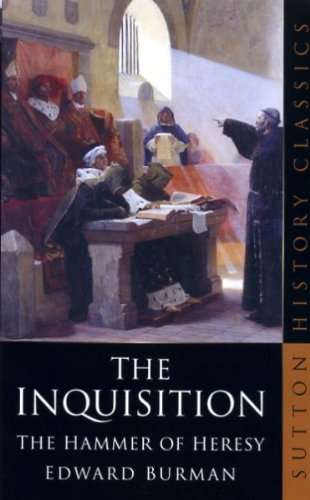
The Inquisition: The Hammer of Heresy
Check my rate
| Main centres: | 1-3 business days |
| Regional areas: | 3-4 business days |
| Remote areas: | 3-5 business days |

| Main centres: | 1-3 business days |
| Regional areas: | 3-4 business days |
| Remote areas: | 3-5 business days |
Published by Sutton Publishing, 2004, softcover, 254 pages, condition: very good.
The author, Edward Urman is a distinguished historian, particularly of the middle ages. His other books include The Templars, Knights of God,The Assassins and Supremely Abominable Crimes, The Trial of the Knights Templar.
When I teach the unit on Medieval Iberia for my "History of Games" class, I usually focus on the 13th and 14th centuries and tell my class that the Spanish Inquisition really took hold in the late 15th century (circa 1478). However, I was very unsatisfied with that point because I realized that I was unfamiliar with the history of the Inquisition as a whole. Edward Burman's The Inquisition: The Hammer of Heresy serves as a corrective to my ignorance.
Did you know that there is still a spiritual descendant to the Inquisition? In 1995, it's name was changed from the "Congregation of the Holy Office" to "The Sacred Congregation for the Doctrine of the Faith" and the current pope was once in charge of it. Of course, we don't see the use of torture and persecution in the current office, but Burman (without being a Catholic apologist) observes that much of the abuse and horrifying torture we ascribe to the Inquisition was actually perpetrated by secular authorities who used the idea of preserving the faith as an opportunity for establishing their own power. Yet, Burman describes some horrifying statistics of heretic burnings that cannot be totally off-loaded to the secular authorities.
Certainly, one of my "take-away" lessons from the book is a warning to modern civilizations who too easily give away their civil liberties for some nice-sounding higher cause. The possibilities for corruption (of the Inquisitors) were ever-present. In the 14th century, Inquisitors were granted full indulgences (an opportunity for license to licentiousness?), allowed to sell off the confiscated goods of convicted heretics (even though the Dominicans and Franciscans were usually Inquisitors and had sworn a vow of poverty, there is ample evidence that this money was kept by aggrandizing Inquisitors), and able to accuse individuals of high social standing and high office with impunity (hence, the possibility of using an accusation for gaining political/social power or revenge). (See p. 53, also 201, 222, 223.)
While not dwelling on the techniques of torture, Burman cites the six most common types of torture used in the Inquisition: 1) the ordeal of water (sort of like medieval waterboarding except the victim was forced to drink jug after jug or skin after skin of water until they risked drowning), 2) the ordeal of fire (not what you think -- this isn't burning them up, it's placing portions of the body, greased with animal fat, close to the fire so that one is literally being gradually cooked), 3) the strappado (sometimes called the "pulley torture," a manacled prisoner with hands tied behind his/her back would be pulled up by those tied hands until suspended to hang heavily in the air, painfully by the wrists), 4) the wheel (again, not what you'd think, but one was tied to a cartwheel to be stretched out and exposed before being beaten with bars, clubs, and hammers), 5) the rack, and 6) the stivaletto (or brodequins, where thick boards are roped to the victim's legs as tightly as possible so that when metal wedges were hammered between the boards and the legs to cause the pressure to force the rope into the victim's flesh). The worst thing about these means of torture was that they were used on "suspects," not "convicted" heretics, used as a means to gain "confession." (see pp. 64-65)